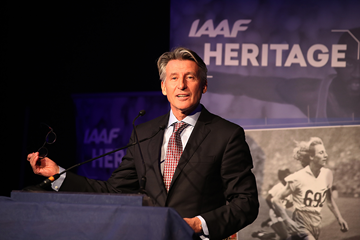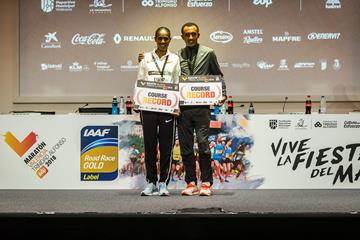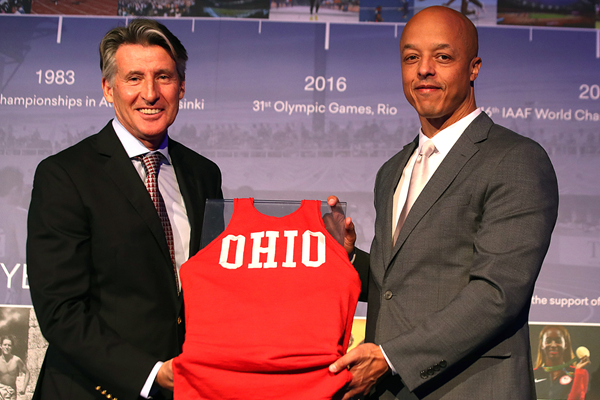The outstanding achievements of Paavo Nurmi, Jesse Owens, Fanny Blankers-Koen, Emil Zatopek, and Irena Szewinska are hard to match in the history of the entire Olympic Games, let alone the sport of athletics.
The families of these five stars were joined on Sunday evening by the representatives of two Olympic champions Emil Voigt and Eric Lemming from the pre-1912 IAAF era at a special IAAF Heritage Legends Reception in Le Meridien Beach Plaza, Monaco.
IAAF President Sebastian Coe, a two-time Olympic 1500m champion himself, hosted the prestigious event during which, and on behalf of the IAAF Heritage Collection, he accepted museum quality artefacts from the careers of these seven deceased legends.
1908 Olympic emblem
Emil Voigt is the 1908 Olympic five miles champion and the last British athlete to win an Olympic long-distance running title before Mo Farah’s 2012 victories. Emil’s granddaughter Robin Voigt donated several items including trophies and medals. The highlight, though, was the framed 1908 British Olympic team’s embroidered emblem which her grandfather had worn when winning gold.
Winning javelin – 1912 Olympic Games
Rajne Soderberg, representing the Swedish Society for the Promotion of Athletics (SCIF) which was founded under Royal Charter in 1897, presented Coe with the birchwood javelin which had won the 1912 Olympic title in Stockholm. The spear had been thrown to victory by Sweden’s four-time Olympic champion Eric Lemming. The SCIF also endowed the Heritage Collection with an original 1912 Olympic Games poster.
1925 bronze bust of Nurmi
Moving into the IAAF era, which began in Stockholm just days after Lemming’s victory, Mika Nurmi the grandson of Finland’s nine-time Olympic champion Paavo Nurmi donated a bronze bust of his grandfather. The bust was presented to Nurmi in 1925 by an American millionaire admirer of ‘The Phantom Finn’ after his famous 55-race tour of the USA. Nurmi was then the most famous sports star on the planet having taken five victories at the 1924 Paris Olympic Games.
Owens’ worn vest
Not to be outdone, the grandson of Jesse Owens, Stuart Rankin, was next on stage to place on long term loan to the Heritage Collection his grandfather’s Ohio State University running vest. The vest which Jesse Owens had worn in competition when representing the Ohio State Buckeyes had been given to Stuart when he was a child. Stuart confirmed that over the decades he had, with understandably great pride, occasionally worn his grandfather’s vest.
Critical letter
Fanny Blankers, the daughter of four-time Olympic champion Fanny Blankers-Koen, handed Coe two impressive frames. One contained the ‘Nederlands’ embroidered emblem from her mother’s 1948 Olympic Games uniform. The other frame was composed of fan mail which her mother received after her four victories. One letter displayed is highly critical of the 30-year-old mother of two for leaving her children at home to compete in sport. Blankers-Koen was very much a role model for the development of women’s sport and the letter was one of many negative messages received by her, among the thousands of well wishes from fans. Also given to the Heritage collection were Fanny’s and her husband and coach Jan’s 1948 Olympic Games accreditation cards and programmes annotated by Jan.
Zatopek’s training suit
At 96 years of age Dana Zatopek, the 1952 Olympic javelin champion, was unable to travel to Monaco to represent her husband Emil Zatopek, the four-time Olympic champion. Instead, Dana sent a video message from her home in Prague which had been recorded by Czech television. She offered her best wishes and generously announced that she was donating Emil’s CSSR tracksuit jacket and one of his training caps. These were then brought on stage and presented to Coe on her behalf.
Szewinska’s spikes
Last but certainly not least, this evening of spectacular additions to the IAAF Heritage Collection was rounded off in style with the appearance on stage of the husband and son of the recently deceased Irena Szewinska. Janusz and Andrzej Szewiński proudly presented two pairs of running spikes from the career of Poland’s three-time Olympic champion. The first pair with fixed long nail like spikes came from Irena’s competitions in the 1960s during which she won Olympic 200m and sprint relay gold. The second pair was from the following decade in which she broke the 400m world record when winning the 1976 Olympic title.
IAAF







 Countdown
Countdown





